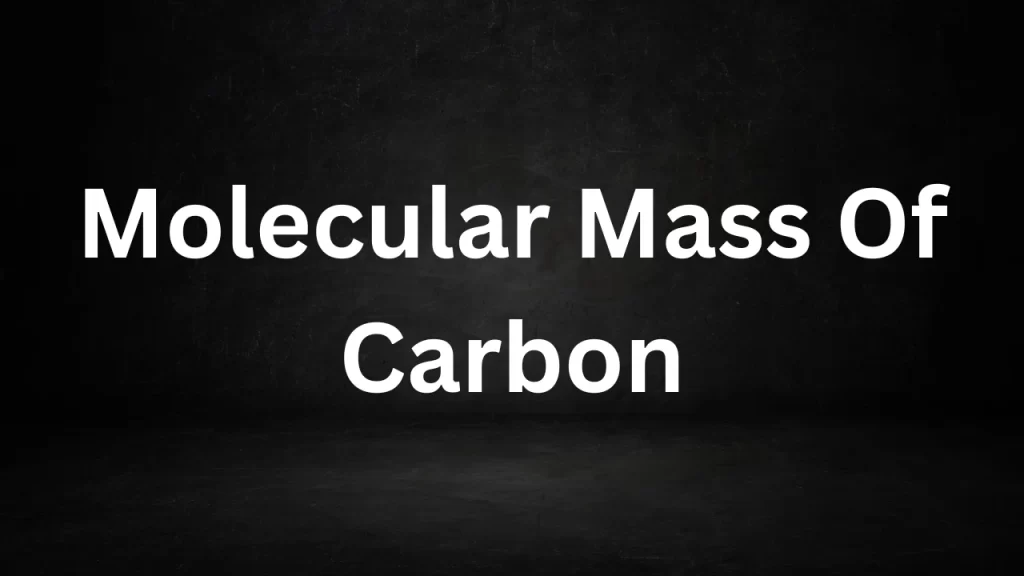Tag: molecular weight of li2co3
Molecular Mass Of Carbon
Molecular Mass Of Carbon: Carbon, often referred to as the “element of life,” is a cornerstone of organic chemistry and the very foundation of life on Earth.
In this article, we will explore the molecular mass of carbon (C), its significance in the world of chemistry, and its vital role in various aspects of science and everyday life.

Molecular Mass Of Carbon
The Significance of Carbon
Carbon is the fourth-most abundant element in the universe by mass and the sixth-most abundant element in the human body by atomic count. Its unique ability to form stable covalent bonds with other carbon atoms and a wide variety of other elements makes it the central building block for organic compounds. Carbon compounds are the basis of life as we know it, forming the structure of DNA, proteins, carbohydrates, and countless other biomolecules. Carbon is also essential in industry, with applications ranging from energy production to materials science and beyond.
Atomic Structure of Carbon
Carbon, with the atomic number 6, has a relatively simple atomic structure. A carbon atom consists of six protons and six neutrons in its nucleus, surrounded by six electrons distributed in two energy levels or electron shells. The electron configuration of carbon is 1s² 2s² 2p², indicating that it has two electrons in the first shell and four in the second shell. The outermost shell, with its four electrons, is known as the valence shell.
Molecular Mass of Carbon
The molecular mass of an element, also known as its molar mass, is defined as the mass of one mole of atoms of that element, measured in grams per mole (g/mol). To calculate the molecular mass of carbon (C), we simply consider the atomic mass of a single carbon atom:
Carbon (C) has an atomic mass of approximately 12.01 g/mol.
Therefore, the molecular mass of carbon is approximately 12.01 grams per mole.
Significance of Molecular Mass in Chemistry
Understanding the molecular mass of carbon is fundamental in chemistry. It serves as a reference point for determining the masses of molecules and compounds that contain carbon atoms. Chemists use this value extensively in stoichiometry, chemical calculations, and the formulation of chemical equations. Additionally, it plays a crucial role in the field of analytical chemistry, where precise measurements of molecular mass are essential for identifying and quantifying compounds.
Conclusion
The molecular mass of carbon, approximately 12.01 g/mol, is a fundamental constant in the realm of chemistry and science at large. It underscores carbon’s significance as the backbone of life on Earth, the building block of organic compounds, and a key element in countless industrial applications. Whether you’re exploring the intricacies of molecular biology, the chemistry of materials, or the energy technologies of the future, a solid grasp of carbon’s molecular mass is indispensable for advancing scientific knowledge and innovation.
Read More
- Molar Mass Of Phosphorus
- Molar Mass of Chlorine
- Electrical Energy And Power
- Dynamics Of Circular Motion
- Molecular Weight Of Acetic Acid
Frequently Asked Questions (FAQs) Molecular Mass Of Carbon
Q1: What is the molecular mass of carbon?
A1: The molecular mass of carbon (C) is approximately 12.01 grams per mole (g/mol).
Q2: Why is the molecular mass of carbon important in chemistry?
A2: The molecular mass of carbon is crucial because it serves as a reference point for determining the masses of molecules and compounds that contain carbon atoms. It plays a fundamental role in stoichiometry, chemical calculations, and the formulation of chemical equations.
Q3: What are some common compounds and molecules that contain carbon?
A3: Carbon is a fundamental element in organic chemistry, and it forms the basis of various compounds and molecules, including:
- Hydrocarbons: Compounds consisting of carbon and hydrogen, such as methane (CH4) and ethane (C2H6).
- Carbohydrates: Sugars, starches, and cellulose, which are essential for energy storage and structural support in living organisms.
- Proteins: Complex biomolecules composed of amino acids, each containing carbon.
- Lipids: Organic molecules like fats and oils that contain carbon and hydrogen.
- Nucleic acids: DNA and RNA, which store genetic information, are composed of carbon, hydrogen, oxygen, nitrogen, and phosphorus.
Q4: How is the mol mass of carbon calculated?
A4: The mol mass of carbon is calculated based on the atomic mass of a single carbon atom. Carbon has an atomic mass of approximately 12.01 g/mol, which is used to determine its mol mass.
Q5: Is carbon unique in its ability to form a wide variety of compounds?
A5: Yes, carbon is unique in its ability to form stable covalent bonds with other carbon atoms and a diverse range of other elements. This versatility allows it to create a vast array of organic compounds, contributing to the complexity and diversity of life and the world of chemistry.